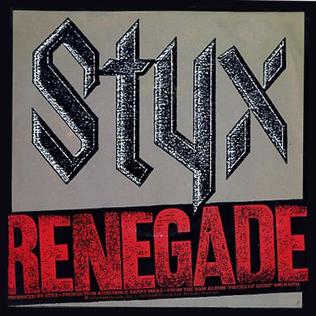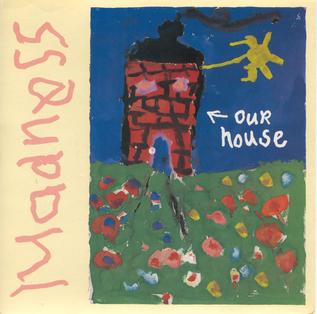
Styx is an American rock band formed in Chicago, Illinois, in 1972. They are known for blending melodic hard rock guitar with acoustic guitar, synthesizers mixed with acoustic piano, upbeat tracks with power ballads, and incorporating elements of international musical theatre. The band established themselves with a progressive rock sound during the 1970s, and began to incorporate pop rock and soft rock elements in the 1980s.

Dennis DeYoung is an American singer, songwriter and keyboardist. He was a founding member of the rock band Styx and served as its primary lead vocalist and keyboardist from 1972 until 1999. DeYoung was the band's most prolific and successful writer, having been credited as the writer of more Styx songs than any other band member. DeYoung penned seven of the band's eight Billboard top 10 singles as well as a solo top 10 single.

Cornerstone is the ninth studio album by the American rock band Styx, released in 1979. Styx's third straight multi-platinum selling album, Cornerstone was Styx's first album to earn a Grammy nomination, which was for Best Rock Performance by a Duo or Group. Like the four previous Styx albums, the band produced the album themselves. Styx recorded the album at Pumpkin Studios in Oak Lawn, Illinois.

Kilroy Was Here is the eleventh studio album by the American rock band Styx, released on February 22, 1983. A concept album and rock opera about a world where rock music is outlawed, it is named after a famous World War II graffiti tag, "Kilroy was here." It was the last album of original material to be released by the "classic" lineup of Dennis DeYoung, Tommy Shaw, James "J.Y." Young, John Panozzo, and Chuck Panozzo.

Caught in the Act is a live double album by Styx, released in 1984. It contains one new song, "Music Time," which was released as a single, reaching #40 on the Billboard Hot 100 charts.

"Renegade" is a 1979 hit song recorded by the American rock band Styx on their Pieces of Eight album. Although songwriter Tommy Shaw and fellow Styx guitarist James Young usually played lead guitar on their own compositions, Shaw asked Young if he could take the solo on "Renegade". Young agreed, and Young later returned the favor by allowing Shaw to play lead on his "Half-Penny, Two-Penny" on the Paradise Theatre album. When performed live from 1978 to 1983, drummer John Panozzo increased the tempo of the drum pattern during the guitar solo sections. Also, the track would serve as the drum solo spot for Panozzo during that time frame.
Kilroy Was Here is a short film made to tie in with the Styx album of the same name. It was played at the beginning of each Styx show on their 1983 tour. It was written and directed by Brian Gibson of Still Crazy, What's Love Got to Do With It, The Josephine Baker Story and Poltergeist II fame.

"Broken Wings" is a 1985 song recorded by American pop rock band Mr. Mister. It was released in June 1985 as the lead single from their second album Welcome to the Real World. The song peaked at number one on the Billboard Hot 100 in December 1985, where it remained for two weeks. It was released as the band was just about to embark on a US tour opening for Tina Turner. "Broken Wings" became the first of two consecutive number ones of the band on the American charts, the other chart-topper being "Kyrie". Outside of the United States, "Broken Wings" topped the charts in Canada, peaked within the top ten of the charts in Australia, Belgium (Flanders), the Netherlands, Norway, the Republic of Ireland, Switzerland, the United Kingdom and West Germany, and the top twenty of the charts in Austria, New Zealand, Spain and Sweden.

"Our House" is a song by the English ska and pop band Madness and was written by second lead vocalist Chas Smash and guitarist Chris Foreman. It was released as the lead single from their fourth studio album, The Rise & Fall, on 12 November 1982. The song charted within the top ten in several countries, and it was the band's biggest hit on the Billboard Hot 100. It won the category Best Pop Song at the May 1983 Ivor Novello Awards.

"Babe" is a song by the American rock band Styx. It was the lead single from the band's 1979 triple-platinum album Cornerstone. The song was Styx's first, and only, US number-one single, spending two weeks at No. 1 in December 1979, serving as the penultimate number-one single of the 1970s. "Babe" also went to No. 9 on the Adult Contemporary chart. It additionally held the number-one spot for six weeks on the Canadian RPM national singles chart, charting in December 1979 and becoming the opening chart-topper of the 1980s. It was also the band's only UK Top 40 hit, peaking at No. 6. It also reached No. 1 in South Africa.

"We've Got Tonite" is a song written by American rock music artist Bob Seger, from his album Stranger in Town (1978). The single record charted twice for Seger, and was developed from a prior song that he had written. Further versions charted in 1983 for Kenny Rogers as a duet with Sheena Easton, and again in 2002 for Ronan Keating.

"Don't Let It End" is the third track and the second top 10 single on the 1983 album Kilroy Was Here, by Styx. The song is also reprised at the end of the album.
Domo arigato is a Japanese phrase meaning "Thanks a lot" or "Thank you very much".

"Mademoiselle" is the first single released from Styx's Crystal Ball album. The B-side, "Lonely Child", was taken from the previous album, Equinox. It peaked at #36 on the Billboard magazine Hot 100 singles chart the week of December 25, 1976, becoming Styx's third top 40 hit. It also reached number 25 on the Canadian RPM singles chart on the week of January 22, 1977.

"Blue Collar Man (Long Nights)" is a song by American rock band Styx, released as the first single from their eighth studio album, Pieces of Eight (1978). Released in 1978, the single came in two 7" vinyl formats: one with the b-side "Superstars" (a track from The Grand Illusion) and a second single with the instrumental album track "Aku-Aku" as the b-side. Some printings of the single were also issued in a translucent blue vinyl, which are now highly sought after collectors items.

"Sing for the Day'" is the second single that Styx released from their album Pieces of Eight. It reached #41 on the U.S. Billboard Hot 100 pop singles chart in February 1979. It was later the B-side of their next single “Renegade”. Tommy Shaw used the name ‘Hannah’ in the song, to represent his fans. Several years later, he named his newborn daughter Hannah. The album version that lasts 4:57, was edited down to 3:40 for the single version.

"Why Me" is a song written by Dennis DeYoung that was first released on Styx's 1979 double-platinum album Cornerstone. It was also released as the second single from the album, and reached #26 on the Billboard Hot 100 and #10 on the Canada RPM Top 100 Singles chart.

"Borrowed Time" is a song written by Dennis DeYoung and Tommy Shaw that was first released on Styx's 1979 album Cornerstone and was also released as the third single from Cornerstone. It peaked at No. 64 on the U.S. chart in April 1980.
"High Time" is the third and final single from the 1983 album, Kilroy Was Here, by Styx. It reached number 48 on the US Billboard Hot 100 singles chart. In a 2009 interview, Dennis DeYoung revealed that "High Time" was released as the third single at the last minute by A&M Records. An expensive video for "Haven't We Been Here Before" was created but never was shown on MTV. Instead, Shaw wanted a live version of "Cold War" to be the third single. A&M Records finally released "High Time" as the single, with little promotion and no video. Its relative poor performance killed momentum on the "Kilroy" album.

"Show Me the Way" is a song by American rock band Styx, written by Dennis DeYoung and released as the second single from Edge of the Century. It peaked at number 3 on the Billboard Hot 100 chart in March 1991. The song's music video was directed by Michael Bay.

















